with引导的独立主格结构讲解与练习
- 格式:doc
- 大小:27.00 KB
- 文档页数:3
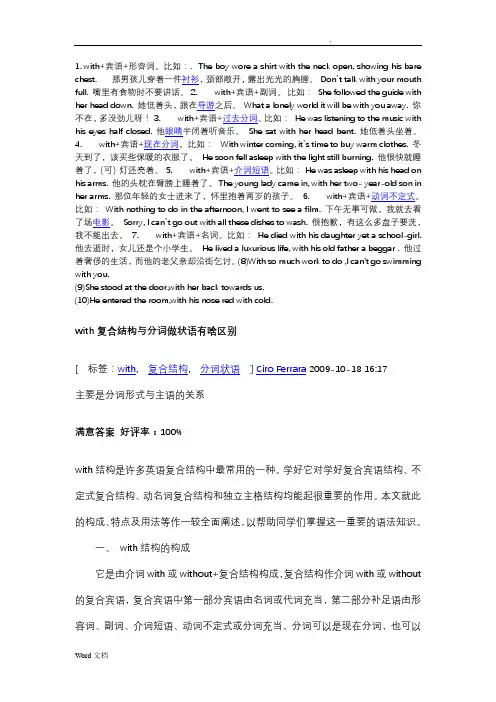
1.with+宾语+形容词。
比如:. The boy wore a shirt with the neck open, showing his bare chest. 那男孩儿穿着一件衬衫,颈部敞开,露出光光的胸膛。
Don’t talk with your mouth full. 嘴里有食物时不要讲话。
2.with+宾语+副词。
比如:She followed the guide with her head down. 她低着头,跟在导游之后。
What a lonely world it will be with you away. 你不在,多没劲儿呀!3.with+宾语+过去分词。
比如:He was listening to the music with his eyes half closed. 他眼睛半闭着听音乐。
She sat with her head bent. 她低着头坐着。
4.with+宾语+现在分词。
比如:With winter coming, it’s time to buy warm clothes. 冬天到了,该买些保暖的衣服了。
He soon fell asleep with the light still burning. 他很快就睡着了,(可)灯还亮着。
5.with+宾语+介词短语。
比如:He was asleep with his head on his arms. 他的头枕在臂膀上睡着了。
The young lady came in, with her two- year-old son in her arms. 那位年轻的女士进来了,怀里抱着两岁的孩子。
6.with+宾语+动词不定式。
比如:With nothing to do in the afternoon, I went to see a film. 下午无事可做,我就去看了场电影。
Sorry, I can’t go out with all these dishes to wash. 很抱歉,有这么多盘子要洗,我不能出去。
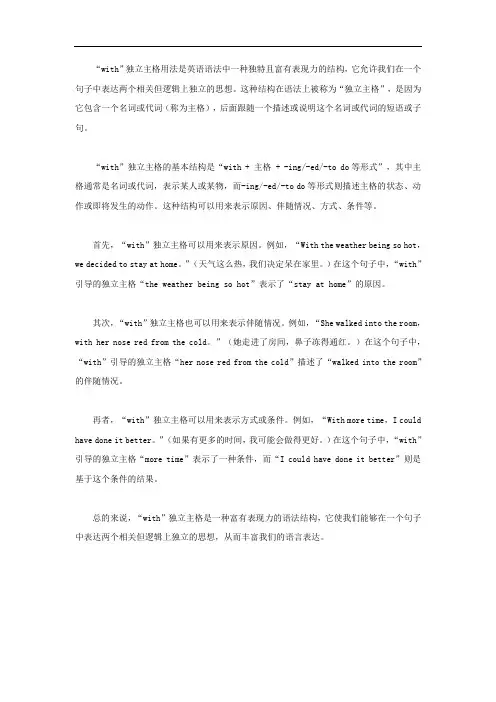
“with”独立主格用法是英语语法中一种独特且富有表现力的结构,它允许我们在一个句子中表达两个相关但逻辑上独立的思想。
这种结构在语法上被称为“独立主格”,是因为它包含一个名词或代词(称为主格),后面跟随一个描述或说明这个名词或代词的短语或子句。
“with”独立主格的基本结构是“with + 主格 + -ing/-ed/-to do等形式”,其中主格通常是名词或代词,表示某人或某物,而-ing/-ed/-to do等形式则描述主格的状态、动作或即将发生的动作。
这种结构可以用来表示原因、伴随情况、方式、条件等。
首先,“with”独立主格可以用来表示原因。
例如,“With the weather being so hot,we decided to stay at home。
”(天气这么热,我们决定呆在家里。
)在这个句子中,“with”引导的独立主格“the weather being so hot”表示了“stay at home”的原因。
其次,“with”独立主格也可以用来表示伴随情况。
例如,“She walked into the room,with her nose red from the cold。
”(她走进了房间,鼻子冻得通红。
)在这个句子中,“with”引导的独立主格“her nose red from the cold”描述了“walked into the room”的伴随情况。
再者,“with”独立主格可以用来表示方式或条件。
例如,“With more time,I could have done it better。
”(如果有更多的时间,我可能会做得更好。
)在这个句子中,“with”引导的独立主格“more time”表示了一种条件,而“I could have done it better”则是基于这个条件的结果。
总的来说,“with”独立主格是一种富有表现力的语法结构,它使我们能够在一个句子中表达两个相关但逻辑上独立的思想,从而丰富我们的语言表达。
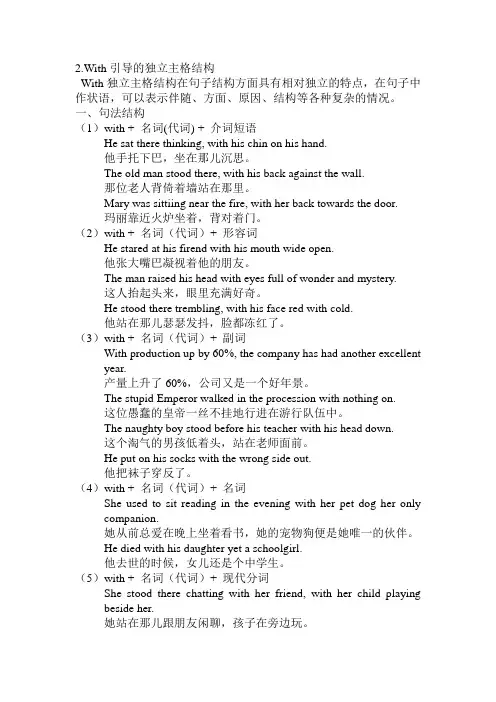
2.With引导的独立主格结构With独立主格结构在句子结构方面具有相对独立的特点,在句子中作状语,可以表示伴随、方面、原因、结构等各种复杂的情况。
一、句法结构(1)with + 名词(代词) + 介词短语He sat there thinking, with his chin on his hand.他手托下巴,坐在那儿沉思。
The old man stood there, with his back against the wall.那位老人背倚着墙站在那里。
Mary was sittiing near the fire, with her back towards the door.玛丽靠近火炉坐着,背对着门。
(2)with + 名词(代词)+ 形容词He stared at his firend with his mouth wide open.他张大嘴巴凝视着他的朋友。
The man raised his head with eyes full of wonder and mystery.这人抬起头来,眼里充满好奇。
He stood there trembling, with his face red with cold.他站在那儿瑟瑟发抖,脸都冻红了。
(3)with + 名词(代词)+ 副词With production up by 60%, the company has had another excellent year.产量上升了60%,公司又是一个好年景。
The stupid Emperor walked in the procession with nothing on.这位愚蠢的皇帝一丝不挂地行进在游行队伍中。
The naughty boy stood before his teacher with his head down.这个淘气的男孩低着头,站在老师面前。
He put on his socks with the wrong side out.他把袜子穿反了。
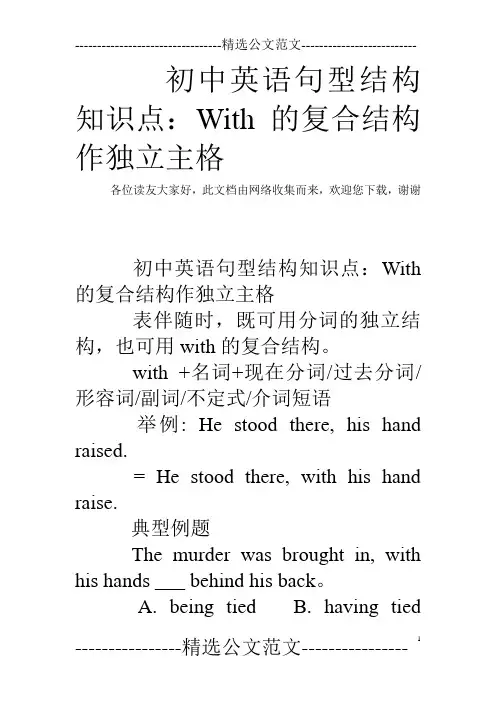
初中英语句型结构知识点:With的复合结构作独立主格
各位读友大家好,此文档由网络收集而来,欢迎您下载,谢谢
初中英语句型结构知识点:With的复合结构作独立主格
表伴随时,既可用分词的独立结构,也可用with的复合结构。
with +名词+现在分词/过去分词/形容词/副词/不定式/介词短语
举例: He stood there, his hand raised.
= He stood there, with his hand raise.
典型例题
The murder was brought in, with his hands ___ behind his back。
A. being tied
B. having tied
C. to be tied
D. tied
答案D. with +名词+分词+介词短语
结构。
当分词表示伴随状况时,其主语常常用with来引导。
由于本句中名词”手”与分词”绑”是被动关系,因此用过去分词,选D.
注意:
1) 独立主格结构使用介词的问题:
当介词是in时,其前后的两个名词均不加任何成分,也不用复数。
但with 的复合结构不受此限制
各位读友大家好,此文档由网络收集而来,欢迎您下载,谢谢。
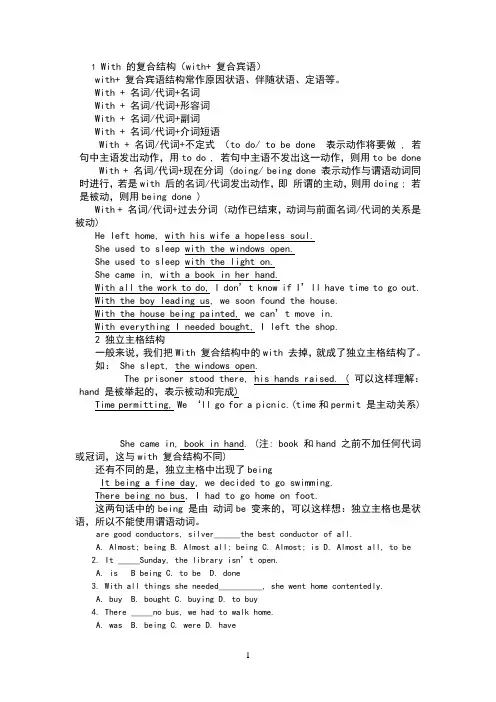
1 With 的复合结构(with+ 复合宾语)with+ 复合宾语结构常作原因状语、伴随状语、定语等。
With + 名词/代词+名词With + 名词/代词+形容词With + 名词/代词+副词With + 名词/代词+介词短语With + 名词/代词+不定式(to do/ to be done 表示动作将要做 , 若句中主语发出动作,用to do , 若句中主语不发出这一动作,则用to be done With + 名词/代词+现在分词 (doing/ being done 表示动作与谓语动词同时进行,若是with 后的名词/代词发出动作,即所谓的主动,则用doing ; 若是被动,则用being done )With + 名词/代词+过去分词 (动作已结束,动词与前面名词/代词的关系是被动)He left home, with his wife a hopeless soul.She used to sleep with the windows open.She used to sleep with the light on.She came in, with a book in her hand.With all the work to do, I don’t know if I’ll have time to go out.With the boy leading us, we soon found the house.With the house being painted, we can’t move in.With everything I needed bought, I left the shop.2 独立主格结构一般来说,我们把With 复合结构中的with 去掉,就成了独立主格结构了。
如: She slept, the windows open.The prisoner stood there, his hands raised. ( 可以这样理解:hand 是被举起的,表示被动和完成)Time permitting, We ‘ll go for a picnic.(time和permit 是主动关系)She came in, book in hand. (注: book 和hand 之前不加任何代词或冠词,这与with 复合结构不同)还有不同的是,独立主格中出现了beingIt being a fine day, we decided to go swimming.There being no bus, I had to go home on foot.这两句话中的being 是由动词be 变来的,可以这样想:独立主格也是状语,所以不能使用谓语动词。
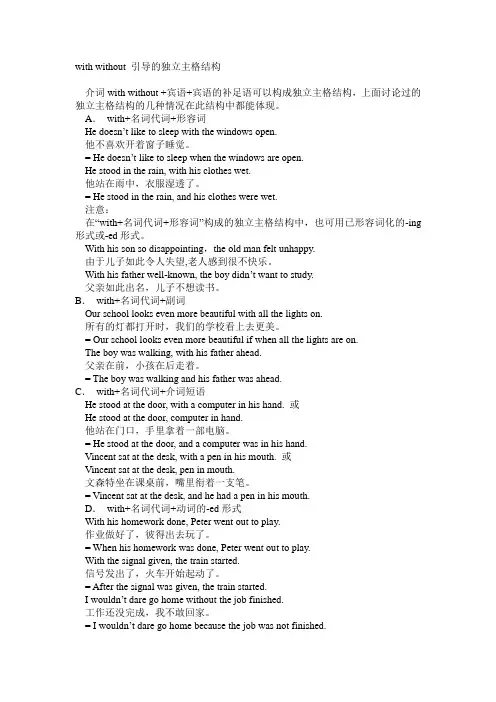
with without 引导的独立主格结构介词with without +宾语+宾语的补足语可以构成独立主格结构,上面讨论过的独立主格结构的几种情况在此结构中都能体现。
A.with+名词代词+形容词He doesn’t like to sleep with the windows open.他不喜欢开着窗子睡觉。
= He doesn’t like to sleep when the windows are open.He stood in the rain, with his clothes wet.他站在雨中,衣服湿透了。
= He stood in the rain, and his clothes were wet.注意:在“with+名词代词+形容词”构成的独立主格结构中,也可用已形容词化的-ing 形式或-ed形式。
With his son so disappointing,the old man felt unhappy.由于儿子如此令人失望,老人感到很不快乐。
With his father well-known, the boy didn’t want to study.父亲如此出名,儿子不想读书。
B.with+名词代词+副词Our school looks even more beautiful with all the lights on.所有的灯都打开时,我们的学校看上去更美。
= Our school looks even more beautiful if when all the lights are on.The boy was walking, with his father ahead.父亲在前,小孩在后走着。
= The boy was walking and his father was ahead.C.with+名词代词+介词短语He stood at the door, with a computer in his hand. 或He stood at the door, computer in hand.他站在门口,手里拿着一部电脑。
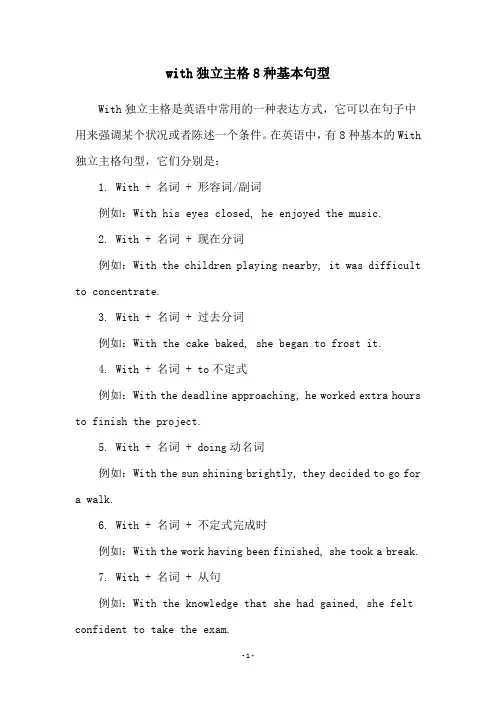
with独立主格8种基本句型With独立主格是英语中常用的一种表达方式,它可以在句子中用来强调某个状况或者陈述一个条件。
在英语中,有8种基本的With 独立主格句型,它们分别是:1. With + 名词 + 形容词/副词例如:With his eyes closed, he enjoyed the music.2. With + 名词 + 现在分词例如:With the children playing nearby, it was difficult to concentrate.3. With + 名词 + 过去分词例如:With the cake baked, she began to frost it.4. With + 名词 + to不定式例如:With the deadline approaching, he worked extra hours to finish the project.5. With + 名词 + doing动名词例如:With the sun shining brightly, they decided to go fora walk.6. With + 名词 + 不定式完成时例如:With the work having been finished, she took a break.7. With + 名词 + 从句例如:With the knowledge that she had gained, she felt confident to take the exam.8. With + 名词 + 介词短语例如:With his hand on her shoulder, he reassured her that everything would be alright.这8种With独立主格句型在英语中使用非常广泛,可以用来表达各种不同的情境和意思。
学会运用它们,能够让我们的英语表达更加地流畅自然。
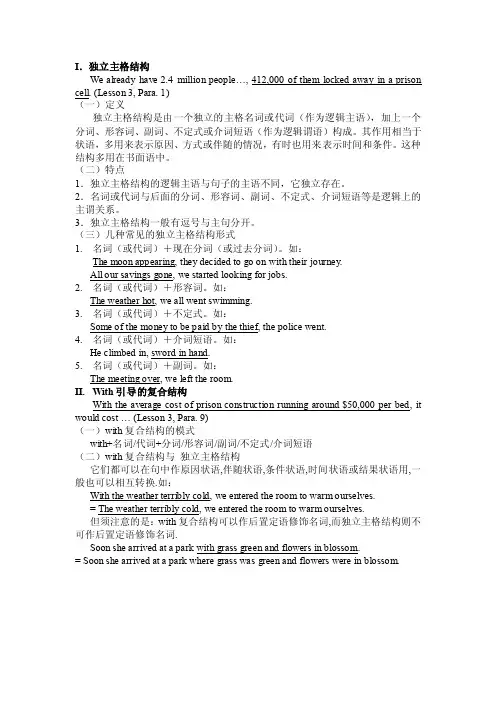
I.独立主格结构We already have 2.4 million people…, 412,000 of them locked away in a prison cell. (Lesson 3, Para. 1)(一)定义独立主格结构是由一个独立的主格名词或代词(作为逻辑主语),加上一个分词、形容词、副词、不定式或介词短语(作为逻辑谓语)构成。
其作用相当于状语,多用来表示原因、方式或伴随的情况,有时也用来表示时间和条件。
这种结构多用在书面语中。
(二)特点1.独立主格结构的逻辑主语与句子的主语不同,它独立存在。
2.名词或代词与后面的分词、形容词、副词、不定式、介词短语等是逻辑上的主谓关系。
3.独立主格结构一般有逗号与主句分开。
(三)几种常见的独立主格结构形式1. 名词(或代词)+现在分词(或过去分词)。
如:The moon appearing, they decided to go on with their journey.All our savings gone, we started looking for jobs.2. 名词(或代词)+形容词。
如:The weather hot, we all went swimming.3. 名词(或代词)+不定式。
如:Some of the money to be paid by the thief, the police went.4. 名词(或代词)+介词短语。
如:He climbed in, sword in hand.5. 名词(或代词)+副词。
如:The meeting over, we left the room.II. With引导的复合结构With the average cost of prison construction running around $50,000 per bed, it would cost … (Lesson 3, Para. 9)(一)with复合结构的模式with+名词/代词+分词/形容词/副词/不定式/介词短语(二)with复合结构与独立主格结构它们都可以在句中作原因状语,伴随状语,条件状语,时间状语或结果状语用,一般也可以相互转换.如:With the weather terribly cold, we entered the room to warm ourselves.= The weather terribly cold, we entered the room to warm ourselves.但须注意的是:with复合结构可以作后置定语修饰名词,而独立主格结构则不可作后置定语修饰名词.Soon she arrived at a park with grass green and flowers in blossom.= Soon she arrived at a park where grass was green and flowers were in blossom.。
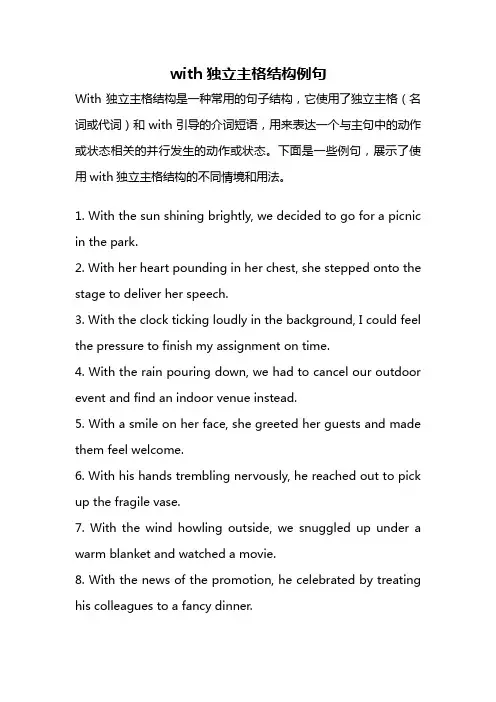
with独立主格结构例句With独立主格结构是一种常用的句子结构,它使用了独立主格(名词或代词)和with引导的介词短语,用来表达一个与主句中的动作或状态相关的并行发生的动作或状态。
下面是一些例句,展示了使用with独立主格结构的不同情境和用法。
1. With the sun shining brightly, we decided to go for a picnic in the park.2. With her heart pounding in her chest, she stepped onto the stage to deliver her speech.3. With the clock ticking loudly in the background, I could feel the pressure to finish my assignment on time.4. With the rain pouring down, we had to cancel our outdoor event and find an indoor venue instead.5. With a smile on her face, she greeted her guests and made them feel welcome.6. With his hands trembling nervously, he reached out to pick up the fragile vase.7. With the wind howling outside, we snuggled up under a warm blanket and watched a movie.8. With the news of the promotion, he celebrated by treating his colleagues to a fancy dinner.9. With a heavy heart, she packed her bags and said goodbye to her family as she left for college.10. With the car engine revving loudly, he sped off down the highway.以上是一些使用with独立主格结构的例句,它们展示了不同的情境和动作,并且符合标题要求。
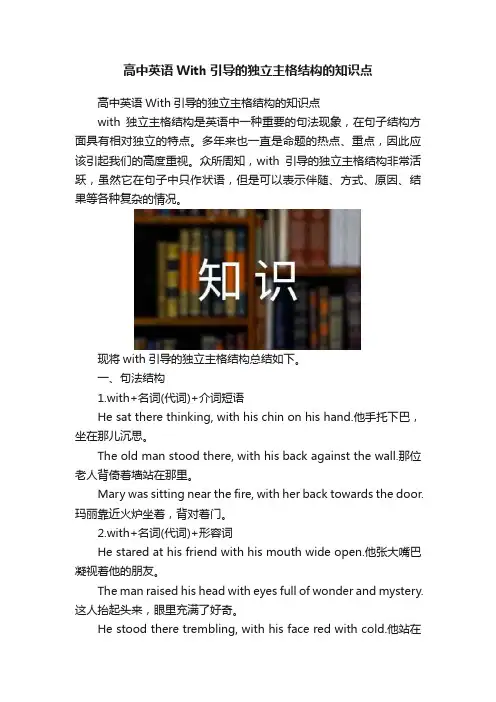
高中英语With引导的独立主格结构的知识点高中英语With引导的独立主格结构的知识点with独立主格结构是英语中一种重要的句法现象,在句子结构方面具有相对独立的特点。
多年来也一直是命题的热点、重点,因此应该引起我们的高度重视。
众所周知,with引导的独立主格结构非常活跃,虽然它在句子中只作状语,但是可以表示伴随、方式、原因、结果等各种复杂的情况。
现将with引导的独立主格结构总结如下。
一、句法结构1.with+名词(代词)+介词短语He sat there thinking, with his chin on his hand.他手托下巴,坐在那儿沉思。
The old man stood there, with his back against the wall.那位老人背倚着墙站在那里。
Mary was sitting near the fire, with her back towards the door.玛丽靠近火炉坐着,背对着门。
2.with+名词(代词)+形容词He stared at his friend with his mouth wide open.他张大嘴巴凝视着他的朋友。
The man raised his head with eyes full of wonder and mystery.这人抬起头来,眼里充满了好奇。
He stood there trembling, with his face red with cold.他站在那儿瑟瑟发抖,脸都冻红了。
3.with+名词(代词)+副词With production up by 60%, the company has had another excellent year.产量上升了60%,公司又是一个好年景。
The stupid Emperor walked in the procession with nothing on.这位愚蠢的皇帝一丝不挂地行进在游行队伍中。
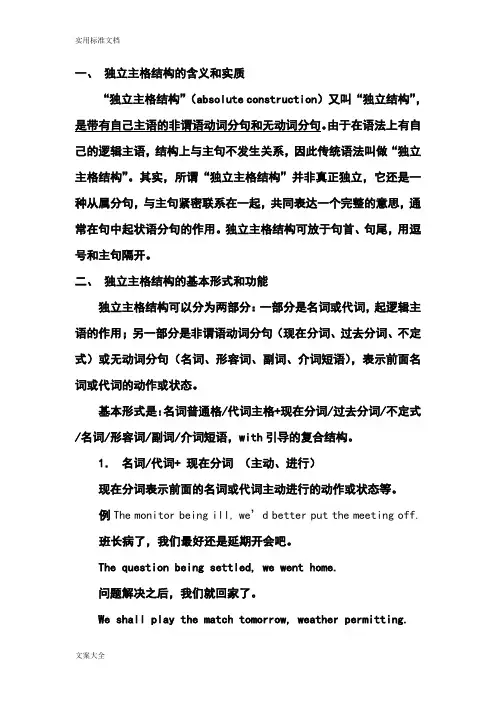
一、独立主格结构的含义和实质“独立主格结构”(absolute construction)又叫“独立结构”,是带有自己主语的非谓语动词分句和无动词分句。
由于在语法上有自己的逻辑主语,结构上与主句不发生关系,因此传统语法叫做“独立主格结构”。
其实,所谓“独立主格结构”并非真正独立,它还是一种从属分句,与主句紧密联系在一起,共同表达一个完整的意思,通常在句中起状语分句的作用。
独立主格结构可放于句首、句尾,用逗号和主句隔开。
二、独立主格结构的基本形式和功能独立主格结构可以分为两部分:一部分是名词或代词,起逻辑主语的作用;另一部分是非谓语动词分句(现在分词、过去分词、不定式)或无动词分句(名词、形容词、副词、介词短语),表示前面名词或代词的动作或状态。
基本形式是:名词普通格/代词主格+现在分词/过去分词/不定式/名词/形容词/副词/介词短语,with引导的复合结构。
1.名词/代词+ 现在分词(主动、进行)现在分词表示前面的名词或代词主动进行的动作或状态等。
例The monitor being ill, we’d better put the meeting off.班长病了,我们最好还是延期开会吧。
The question being settled, we went home.问题解决之后,我们就回家了。
We shall play the match tomorrow, weather permitting.明天假设天气好,我们就进行比赛。
So many students being absent, the meeting had to be put off.His homework having been done, Tom went to sleep.注:“独立结构”中的being或 having been 有时可以省去,这样就成了无动词分句或过去分词分句。
2.名词/代词+过去分词(被动、完成)过去分词表示前面的名词或代词被动完成的动作或所处的一种状态。
高三英语独立主格结构with的复合结构试题1. The story is about an old Indian farmer and an American tourist in India,__ understanding the other’s language.A.none of whom B.both of themC.neither of them D.neither of whom【答案】C【解析】考查独立主格结构。
句意:这个故事是关于一个印度村民和一个美国游客,他们两个人都不能理解对方的语言。
独立主格结构不是句子,是短语,它的作用相当于句子。
AD构成的是定语从句。
故被排除。
根据句意可知这两个人不能相互理解。
故C正确。
考点 : 考查独立主格结构2. Experts insist that packets of cigarettes come with a health warning ______ to them.A.be attached B.attach C.attached D.attaching【答案】C【解析】试题分析:句意:专家坚持要求要让香烟的包装上附带上健康警告。
此处是with复合结构,即:“with +宾语+to do / doing / done”形式,而宾语warning 和动词attach之间是动宾关系,应该用过去分词表示被动,选C。
【考点】考查动词时态。
3. ________,John returned to school from his hometown.A.The summer vacation being overB.The summer vacation is overC.Because the summer vacation overD.After the summer vacation being over【答案】A【解析】做题时首先分析句子结构,确定句子类型。
.1. with+ 宾语 +形容词。
比如: . The boy wore a shirt with the neck open, showing his barechest.那男孩儿穿着一件衬衫,颈部敞开,露出光光的胸膛。
Don ’ttalk with your mouth full. 嘴里有食物时不要讲话。
2.with+ 宾语 + 副词。
比如: She followed the guide with her head down. 她低着头,跟在导游之后。
What a lonely world it will be with you away.你不在,多没劲儿呀! 3.with+ 宾语 + 过去分词。
比如: He was listening to the music with his eyes half closed.他眼睛半闭着听音乐。
She sat with her head bent.她低着头坐着。
4.with+ 宾语 + 现在分词。
比如:With winter coming, it’s time to buy warm clothes.冬天到了,该买些保暖的衣服了。
He soon fell asleep with the light still burning.他很快就睡着了,(可)灯还亮着。
5.with+ 宾语 + 介词短语。
比如: He was asleep with his head on his arms. 他的头枕在臂膀上睡着了。
The young lady came in, with her two- year-old son inher arms.那位年轻的女士进来了,怀里抱着两岁的孩子。
6.with+ 宾语 + 动词不定式。
比如: With nothing to do in the afternoon, I went to see a film.下午无事可做,我就去看了场电影。
with独立主格结构就是英语的一种重要的句法现象,在句子结构方面具有相对独立的特点。
多年来也一直就是命题的热点、重点,因此应该引起我们的高度重视。
众所周知,with引导的独立主格结构非常活跃,虽然它在句子中只作状语,但就是可以表示伴随、方式、原因、结果等各种复杂的情况。
现将with引导的独立主格结构加以小结。
一、句法结构【结构一】with +名词(代词)+介词短语【例句】He sat there thinking, with his chin on his hand、她手托下巴,坐在那儿沉思。
The old man stood there, with his back against the wall、那位老人背倚着墙站在那里。
Mary was sitting near the fire, with her back towards the door、玛丽靠近火炉坐着,背对着门。
【结构二】with +名词(代词)+形容词【例句】He stared at his friend with his mouth wide open、她张大嘴巴凝视着她的朋友。
The man raised his head with eyes full of wonder and mystery、这人抬起头来,眼里充满了好奇。
He stood there trembling, with his face red with cold、她站在那儿瑟瑟发抖,脸都冻红了。
【结构三】with +名词(代词)+副词【例句】With production up by 60%, the company has had another excellent year、产量上升了60%, 公司又就是一个好年景。
The stupid Emperor walked in the procession with nothing on、这位愚蠢的皇帝一丝不挂地行进在游行队伍中。
我们在阅读或在翻译一些文章的时候经常会碰到“With + 独立主格”结构,这一结构并不是一个独立的单句,但其句法作用却相当于一个单句,大多数情况下它在句子中充当状语,可以表示时间、原因、条件、让步、方式、伴随状况、附加说明等等。
这一结构在句子中即可以放在句首,也可以放在句尾。
With 后面的独立主格结构(Absolute Construction)是由名词(也可以是代词)加现在分词、过去分词、介词短语、形容词、副词、不定式等构成。
下面根据with 后独立主格所涉及到的成分通过例句的形式对这一结构加以说明。
1.With +名词+过去分词▪ They left with most of their work undone.(大部分的工作还没有做他们就离开了)▪ The year 2000 ended with nothing settled. (2000年过去了,什么也没有解决)▪ The prisoner was brought in with his hands tied and feet chained. (囚犯被带了进来,手被捆着,脚被锁链锁着。
)▪ The shopping bag ladies wear layers of clothes, with newspapersstuffed between the layers as further protection against cold.(流浪女穿着一层层的衣服,层与层之间还塞满了报纸来进一步抵御严寒)2.With +名词+现在分词▪ She stood on the top of the hill with her hair flowing in the breeze.(她站在小山顶上,长发在微风中飘拂)▪ I was about to declare myself here in Southampton with trainsrattling overhead.(在南安普敦,火车在我上面的铁轨上隆隆作响,我就要表明我自己的身份,开始拉琴卖艺了。
With 的复合宾语结构及分词的独立主格结构with 的复合宾语结构是高考的一个重点;分词的独立主格结构不是句子,因为没有实际的主语和谓语,该结构放在句首或句尾。
两者的语法功能和结构是相同的。
即两者在句中作状语,独立主格结构前加with 就构成了with的复合宾语结构。
㈠with 的复合宾语结构1.With+名词或代词+v-ingWith the crowds cheering, they drove to the palace. <伴随状语>=While____________________________________________________.With Peter working in Birmingham and Lucy travelling most of the week, the house seems pretty empty. <原因状语>=Because _________________________________________________.With time going on, our life is becoming more beautiful. <时间状语>= As______________________________________________________.※with后名词或代词与后面动词存在逻辑上主谓关系,即主动关系。
2. With+名词或代词+v-edWith the decision made, the next problem was how to make a good plan.=After ___________________________________________________.With the job finished, we went home straight away.=Because___________________________________________________.With more time given, I’ll explain this item in detail.=If _______________________________________________________.※with后名词或代词与后面动词存在逻辑上动宾关系,即被动关系。
高二英语独立主格结构with的复合结构试题1. With everything she needed ________, she went out of the shop, with her hands full of shopping bags.A.bought B.to buy C.buying D.buy【答案】A【解析】句意:因为每一样东西都需要买,她去了商店,满手都是购物袋。
这是with 复合结构,由于everything 和buy 之间为被动关系,故用过去分词作宾语补足语,选A。
【考点】考查with 复合结构2. With all things _______, we should follow his advice.A.considered B.having consideredC.being considered D.Considering【答案】A【解析】试题解析:考查的with的复合结构。
宾语all things 与宾补consider构成动宾关系表被动和完成,所以选A. BD为主动形式,C为进行时的被动语态。
句意:考虑了所有问题之后,我们应该听从他的建议。
【考点】考查的with的复合结构。
3. For example, don't keep looking at the ground or staring into space, or talk with your arms_____A.cross B.crossed C.crossing D.to cross【答案】B【解析】考查with复合结构:句意:不要总是东看西看或者盯着空白处,或是交叉双臂与人交流。
这里用with的复合结构,with+宾语+宾语补足语,因为arms和cross是被动关系,用过去分词做宾语补足语,选B。
【考点】考查with复合结构4. Will was lying on the grass, _______the sky thick with stars.A.his eyes fixing on B.fixed his eyes onC.his eyes were fixed on D.his eyes fixed on【答案】D【解析】考查独立主格结构,分析句子成分,前面的是个简单句,两句话之间没有连词,所以逗号后面不是简单句,而是独立主格结构,逻辑主语+非谓语动词,his eyes和fix是被动关系,用过去分词,句意:Will正躺在草地上,眼睛注视着星星密布的天空。
with引导的独立主格结构
英语中,with引导的独立主格结构很富有表现力,在句子中作状语,表示伴
随、方式、原因、结果等。它不是句子而是短语,其结构为:with+名词/代词
+介词短语/ 形容词 /副词 / 名词 / 非谓语动词。公式:with+宾语+宾补
(with复合结构)。 现将with引导的独立主格结构作一小结。
1. with +名词(代词)+介词短语
He sat there thinking, with his chin on his hand.
他手托下巴,坐在那儿沉思。
The old man stood there, with his back against the wall.
那位老人背倚着墙站在那里。
Mary was sitting near the fire, with her back towards the door.
玛丽靠近火炉坐着,背对着门。
2. with +名词(代词)+形容词
He stared at his friend with his mouth wide open.
-
他张大嘴巴凝视着他的朋友。
The man raised his head with eyes full of wonder and mystery.
这人抬起头来,眼里充满了好奇。
He stood there trembling, with his face red with cold.
他站在那儿瑟瑟发抖,脸都冻红了。
3. with +名词(代词)+副词
With production up by 60%, the company has had another excellent
year.
产量上升了60%, 公司又是一个好年景。
The stupid Emperor walked in the procession with nothing on.
这位愚蠢的皇帝一丝不挂地行进在游行队伍中。
The naughty boy stood before his teacher with his head down.
~
这个淘气的男孩低着头站在老师面前。
He put on his socks with the wrong side out.
他把袜子穿反了。
4. with +名词(代词)+现在分词
She stood there chatting with her friend, with her child playing beside
her.
她站在那儿跟朋友闲聊,孩子在旁边玩。
With winter coming on, the leaves turn yellow.
随着冬天的到来,树叶变黄了。
5. with +名词(代词)+过去分词
With the key lost, she could not enter the room.
钥匙弄丢了,她进不了房间。
)
The murderer was brought in, with his hands tied behind his back.
那个杀人犯被带进来,双手被绑在后面。
6. with +名词(代词)+不定式
With 10 minutes to go, you’d better hurry.
还有十分钟,你最好快一点。
With you to lead us, our group is sure to succeed.
有你领导我们,我们组肯定能成功。
Have a try!
1. I couldn’t do my homework with all that noise______.
A. going on B. goes on C. went on D. to go on
2. The boy sat listening to the old man, ________.
>
A. opened his mouth widely B. and opening his wide mouth
C. with his mouth wide open D. his mouth was opened widely
3. ______, he would most probably be late.
A. Without anybody to call him B. Anybody to call him
C. Nobody called him D. With him to call
4. _________, we are all sure of its success.
A. With Tom taking charge of the work B. With Tom is taking charge on
the work
C. His taking charge of the work D. With he taking charge of the
work
5. With all factors________, we think this program will be a success.
A. being considered B. considering
C. considered D. are considered
,
6. With a lot of difficult problems _______, the newly-elected president
is having a
hard time.
A. settled B. settling C. to settle D. being
settled
7. _______ two exams to worry about, I have to work really hard this
weekend.
A. With B. Besides C. As for D. Because of
8. The square looks far more beautiful _______.
A. with all the lights turning on B. all the lights turning
on
C. turning on all the lights D. with all the lights
turned on
9. He walked _______.
A. with his head held high B. held his head highly
C. his head holding highly D. with his head to hold high
!
10. It’s quite strange that the man sleeps with his mouth _____ and his
eyes _______.
A. closed; open B. closed; opened C. closing; open D. closing;
opening
11. The old man sat on the chair, ____________.
A. with a pipe was in his hand B. a pipe was in his hand
C. with a pipe in his hand D. a pipe in hand
12. __________, he can’t go out for a walk as usual.
A. With so much work to do B. So much work doing
C. With so much work done D. With doing so much work
13. —Come on, please give me some ideas about the project.
—Sorry. With so much work ______ my mind, I almost break down.
A. filled B. filling C. to fill D. being filled
14. I used to sleep __________________( 开着窗户 ).
15. The hunter went into the forest _________________( 肩上扛着枪 ).
16. ________________( 有老师帮助我们), we will surely succeed.
17. John received an invitation to dinner, and _________________ ( 所
有的工作都
做完了), he gladly accepted it.
18. ________________(由一个当地人带路), we found the small village
easily.